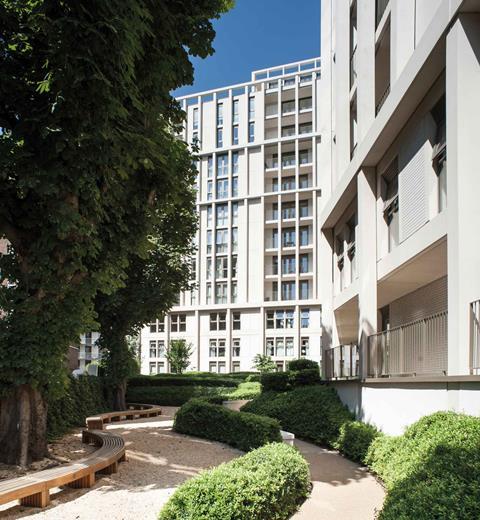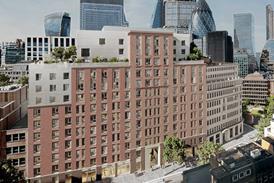Report claims tall buildings do not deliver high densities as claimed, and that boom in high rises has not helped address housing crisis

Policy Exchange has released a new report that criticises what it describes as Britain’s “mania for tall buildings”.
Authored by Ike Ijeh, a former BD architecture critic, and titled Tall Buildings: A Policy Framework for Responsible High-Rise & Better Density, the report asserts that far from helping address the UK housing crisis, tall buildings have in fact “made it worse”.
Policy Exchange says its research indicates that the 68 new residential towers in London since 2000 have provided over 22,000 housing units, of which only 6% were affordable, and 0.3% designated as social housing.
The report also challenges the belief that high-rise buildings are the best solution for achieving high densities in cities. Instead, it points to academic research that suggests mid-rise developments are often more efficient in optimising density and housing supply.
“…diverting attention away from the opportunities presented by these potentially more efficient and contextually sympathetic forms of mid-rise housing, the indiscriminate proliferation of tall buildings has also caused grave harm to the historic fabric in several cities, especially London and Manchester.”
The report cites Abell and Cleland House in Westminster, by DSDHA, as an example of a modern mid-rise mansion block, delivering higher densities than many high rise residential developments.

Ijeh argues that the thinktank’s research indicates that despite the proliferation of tall buildings, London’s density levels remain lower than cities like Paris and Barcelona, which have embraced mid-rise development. He also argues that the seemingly unplanned spread of tall buildings has led to harm to historic fabric in cities like London and Manchester, resulting in the loss of heritage assets and key views.
The report quotes Alain de Botton lamenting that the current London skyscraper boom is turning the capital into a “bad version of Shanghai or Dubai”, and columnist Simon Jenkins bemoaning the “urban anarchy” that was permitting “a forest of giant towers to wreck the city”.
It also claims that public opinion reflects concerns about the impact of tall buildings on historic views and city skylines, asserting that many people now view London’s skyline negatively due to tall building development.
In a foreword to the report, Griff Rhys Jones writes: “The City of London is a shiny, crooked wall. It is difficult to distinguish where one unimaginative, glass-clad slab ends, and another begins.”
Of mid-rise development, Rhys Jones suggests that ”Architects seem inculcated to hate this solution”, due to its lack of “egotistical grandiosity”.
Ijeh also highlights democratic concerns regarding public involvement in decision-making processes related to tall building development. The lack of a comprehensive city-wide tall buildings policy in London exacerbates these issues, asserts the report, undermining trust in the planning system.
The report calls for a new clear Tall Buildings Policy to address these challenges by prioritising beauty and design quality, protecting heritage, and giving the public a greater voice in decision-making processes.
It also advocates for the adoption of alternative mid-rise housing types to achieve higher densities and vibrant communities while preserving the character of cities.
>> Also read: London’s skyline is a mess. Should architects feel ashamed?
>> Also read: A disaster foretold - how a decade of high-rise architecture has blighted London’s skyline
The report’s recommendations:
1. The government should enact legislation mandating that all local authorities in England and Wales considering planning applications for multi-storied buildings over 60m (197ft) in height must first have an approved Tall Buildings Policy. Compliance with Tall Building Policies will become a mandatory, statutory planning requirement for any tall building proposal over 60m across England and Wales.
2. A Tall Building Policy could either be integrated into the Local Development Plan or established as a separate, enforceable document. Local councils failing to develop this plan would forfeit the authority to consider planning applications for tall buildings over 60m in height. Councils not desiring tall buildings within their jurisdiction would be exempt from requiring a Tall Building Policy.
3. Similar to local development plans, a Tall Building Policy would need approval from the planning inspector before becoming enforceable. To obtain approval, a Tall Building Policy would be mandated to:
- Explicitly demonstrate adherence to six Requirements: Location, Beauty, Heritage, Views, Public Consultation, and Alternative Viability.
- Define specific areas suitable and unsuitable for tall buildings.
- Establish a three-tier protected views system akin to historic building grade listings.
- Require public votes on tall building proposals, detailing voting procedures and majority thresholds.
- Introduce guidelines for beauty and design quality.
4. Tall buildings should be prohibited from Conservation Areas, with a protective buffer zone implemented around them. Exceptions would only apply to Conservation Areas with existing tall buildings at the time of their designation.
5. All tall building proposals should undergo a mandatory public vote as part of the statutory consultation process and before submitting the planning application. Although non-binding, the outcome of the vote must be considered by the local authority in granting planning permission.
6. In London, the Greater London Authority would be responsible for producing the Tall Building Policy. Tall building proposals in London would be subject to a ‘Local Lock’, requiring majority support from both the Borough and London as a whole to demonstrate public approval.
7. To promote mid-rise housing, permission-in-principle should be automatically granted to qualifying alternative mid-rise housing schemes. Tall building developers should be obligated to demonstrate that their proposed developments offer greater density than alternative mid-rise housing.
















1 Readers' comment